What is HPP?
Disease definition and incidence
Hypophosphatasia (HPP) is a rare inherited metabolic disorder caused by loss-of-function mutations in the alkaline phosphatase liver/bone/kidney (ALPL) gene, which encodes tissue non-specific isoenzyme of alkaline phosphatase.1-4 This results in defective mineralization of bones and teeth, as well as other manifestations of the disease, including respiratory problems and seizures in infants and, in older patients, muscle weakness, musculoskeletal pain, limited mobility, fractures/pseudofractures, and other manifestations.1-3,5
Severe HPP occurs in 1:300,000 births and milder HPP has been reported by some sources to occur in up to 1:6,370 births.4 The overall incidence and prevalence of all forms of HPP is not known.
Diagnosis of HPP
Persistently low age- and sex-adjusted serum alkaline phosphatase (ALP) activity, in addition to clinical manifestations of the disease and in the absence of other factors that may contribute to low ALP activity, is adequate to confirm HPP diagnosis in most cases. Elevated serum pyridoxal 5'-phosphate (PLP) or urinary phosphoethanolamine can confirm the diagnosis. Although PLP (vitamin B6) may not be elevated in all patients, it is the most sensitive ALP substrate marker for HPP.7-9
Although, to date, at least 400 disease-causing mutations in the ALPL gene for both autosomal dominant and recessive inheritance patterns have been identified, genetic confirmation is not required for diagnosis.1,10,11
Integral to the diagnostic evaluation are the considerations listed below, with the key diagnostic indicator being low age- and sex-adjusted serum ALP activity level.3,5
- Clinical and laboratory findings
- Skeletal manifestations
- Systemic complications (neurological, renal, respiratory, muscular, rheumatologic)
- Dental manifestations
- Family history of siblings or parents with HPP
It is important to note that normal ranges for serum ALP activity are higher in infants, children, and adolescents than they are in adults.12,13 Laboratories vary in their age- and sex-adjusted reference ranges; therefore, serum or plasma ALP activity must be interpreted based upon laboratory-specific reference ranges.14
ALP reference ranges
The tables below show two examples of age- and sex-adjusted reference ranges.13
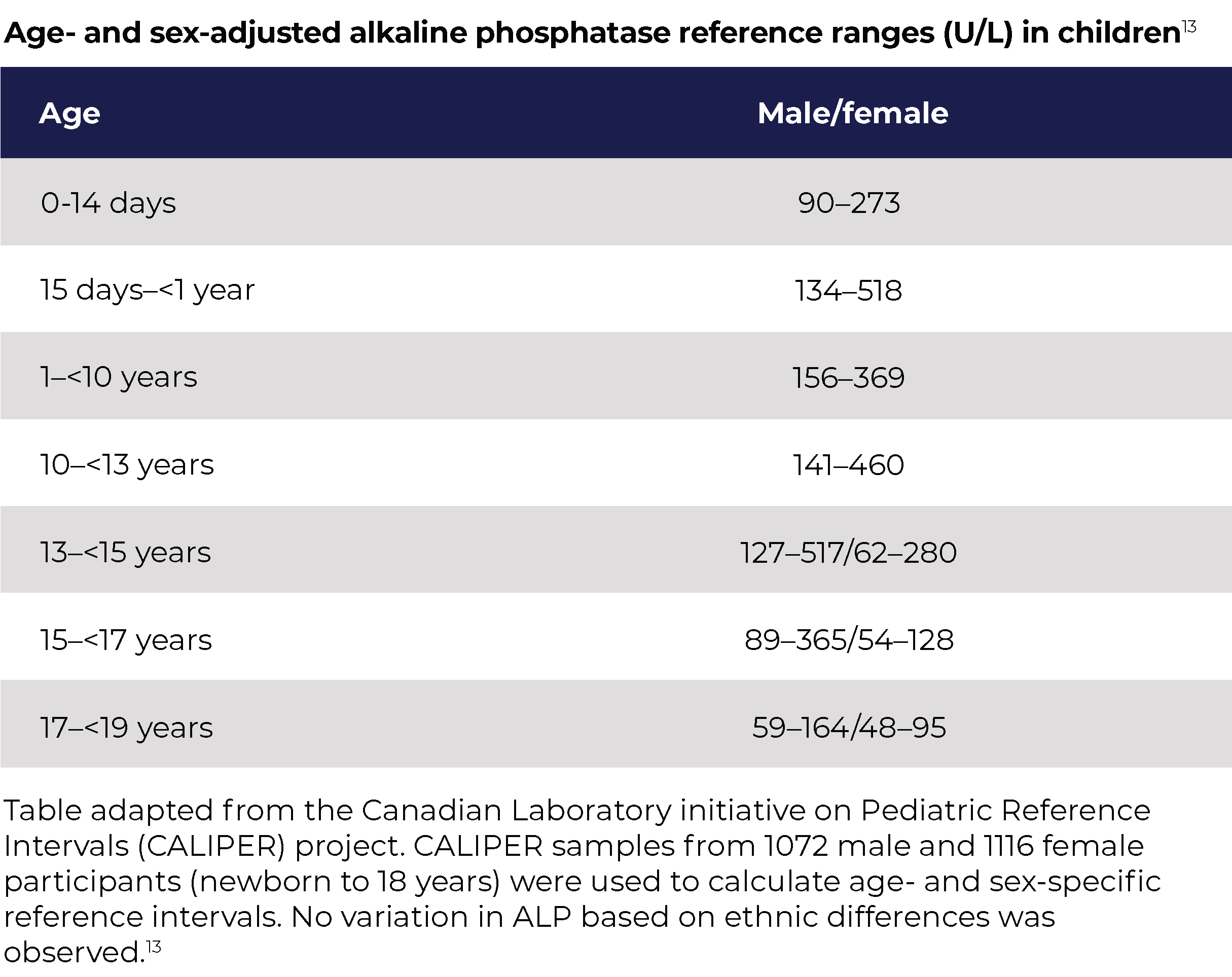
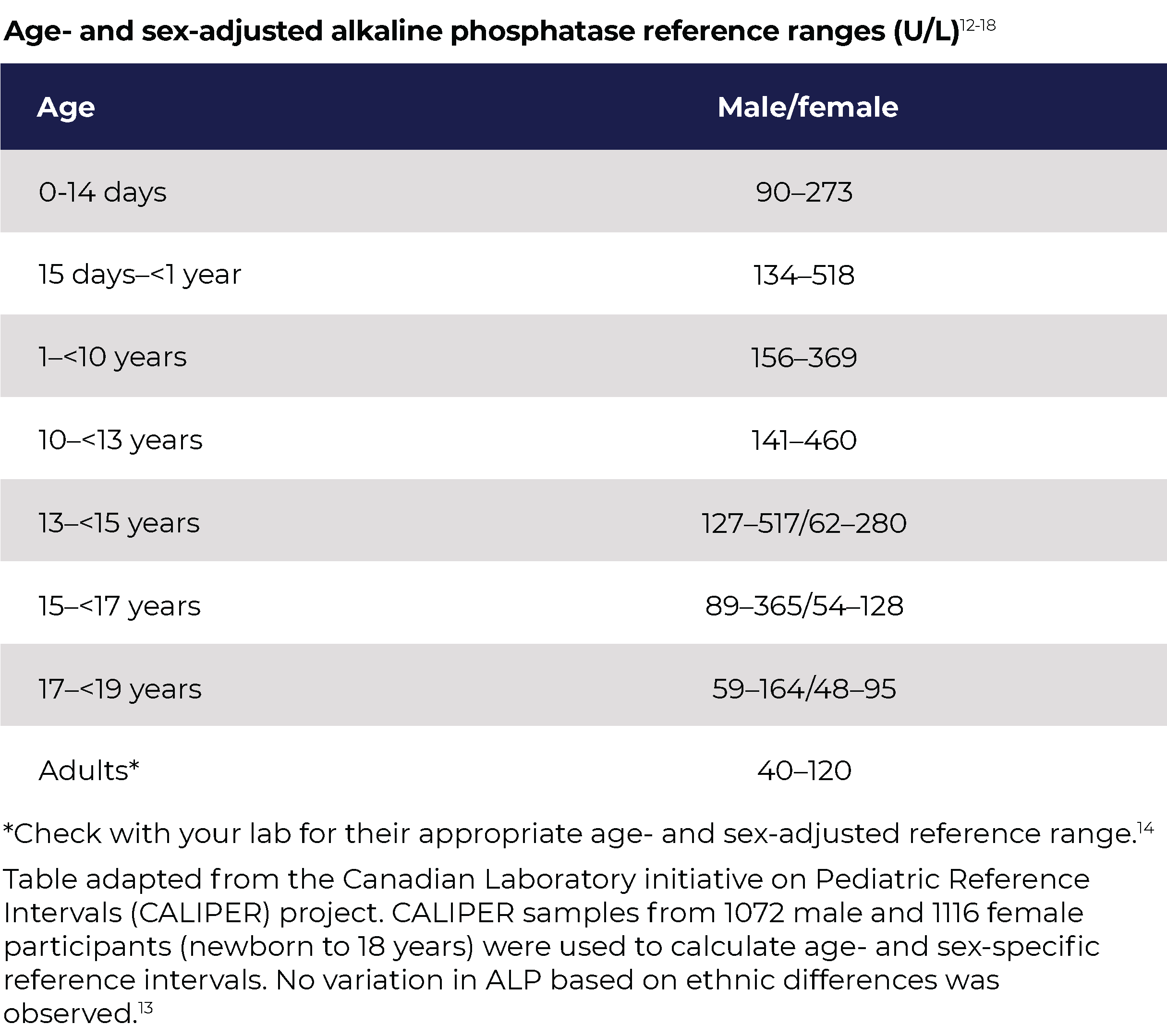
Full reference values depend on the method used and population sampled. The low normal total serum or plasma ALP activity is specific to the laboratory from which measurement of ALP activity is ordered and differs among laboratories. Empiric historical references for the laboratory employed should be preferentially used.19
Clinical manifestations
While HPP is frequently diagnosed during childhood, it may not be diagnosed until adulthood in some patients, even though patients may have had symptoms of the disease for years.6,20,21 The manifestations of HPP are broad, ranging from death in utero or during infancy, with almost no skeletal mineralization, to dental problems in older patients without any apparent bone involvement.22,23 In the literature, mortality has been reported to be 50–100% within the first year of life in the most severely affected patients (neonates and infants with HPP).6,7,24 Data from a noninterventional, retrospective chart review study of 48 neonates and infants with severe HPP estimated 73% mortality at 5 years of age.25
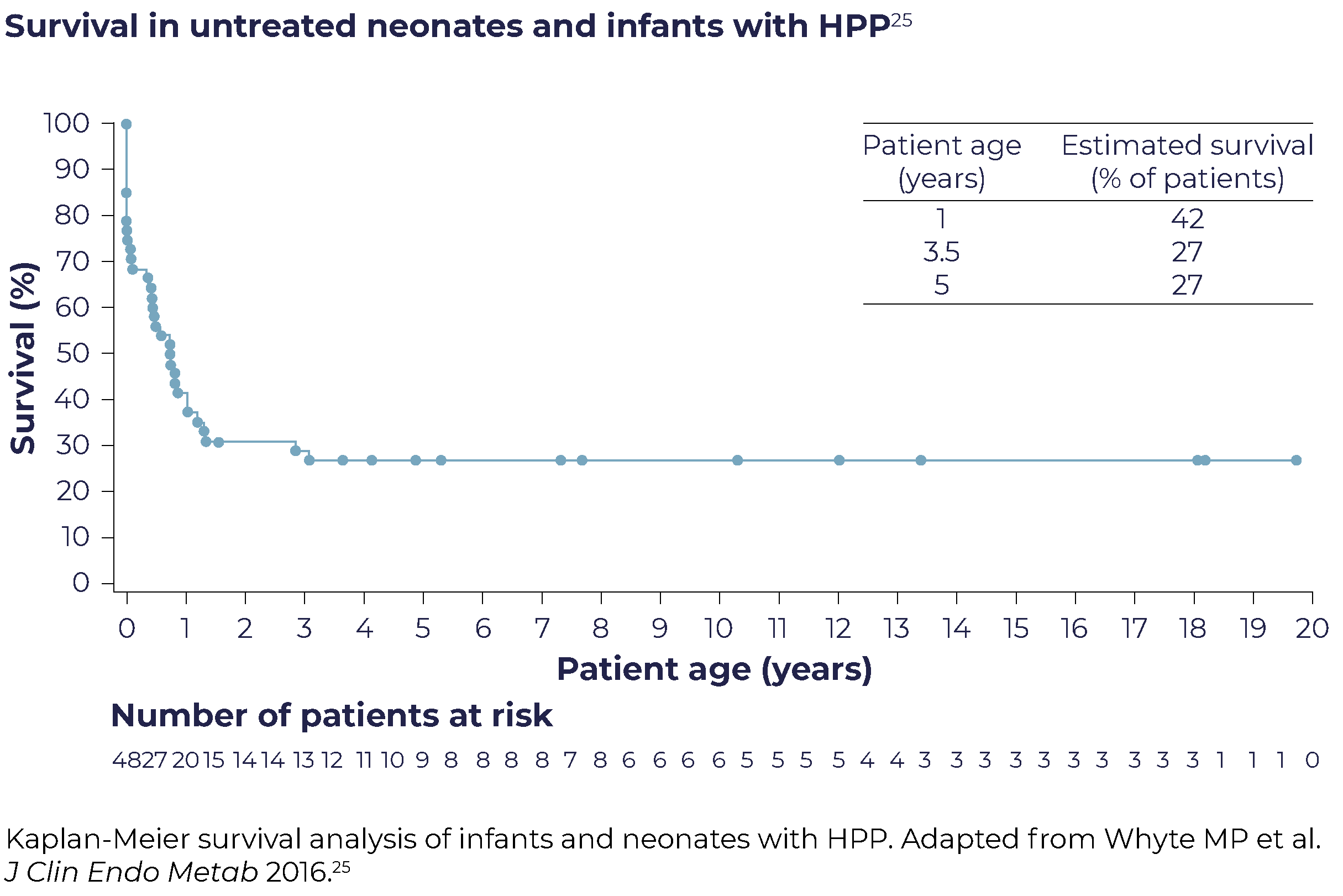
Irrespective of the age at onset, HPP has the potential to cause significant morbidity and disability in patients of any age.1,22 The tables below provide a tool to assist in gathering information about the clinical signs and symptoms of HPP, but should not replace professional judgement or clinical decision making.


Radiographic findings
In children with open growth plates, signs of rickets are visible on plain radiographs. Physeal widening may be seen along with irregularity of the provisional zone of calcification, as well as metaphyseal flaring with areas of radiolucency adjacent to areas of osteosclerosis. In infants and young children with HPP, bone demineralization can progress rapidly. For example, bones that are visible but deformed at birth may show rapid loss of skeletal mineral and severe rachitic changes within the first several months of life. Cupping and fraying of the metaphyses of long bones, widened growth plates, and spotty demineralization of the epiphyses can be seen.1,22 A radiolucent “tongue” shape is commonly seen projecting from the epiphysis into the metaphysis of long bones.1,22 Premature bony fusion of all cranial sutures (craniosynostosis) can occur, and can give the skull a “beaten-copper” appearance on radiographs.3,22 Other radiographic indicators include rachitic ribs and bone fractures.3,22,37,43
In adults, recurrent and/or poorly healing fractures are seen frequently in the metatarsus and femur/hip.8,37,44 Subtrochanteric femoral “stress” fractures might be observed and are actually pseudofractures (Looser’s zone, Milkman fracture) characteristic of the osteomalacia of HPP.7,22 Radiographic chondrocalcinosis and documented pyrophosphate arthropathy have also been observed.8
Differential diagnosis
Misdiagnosis of HPP is common and can lead to ineffective management that can compound the clinical picture and worsen HPP.19,27,43,45
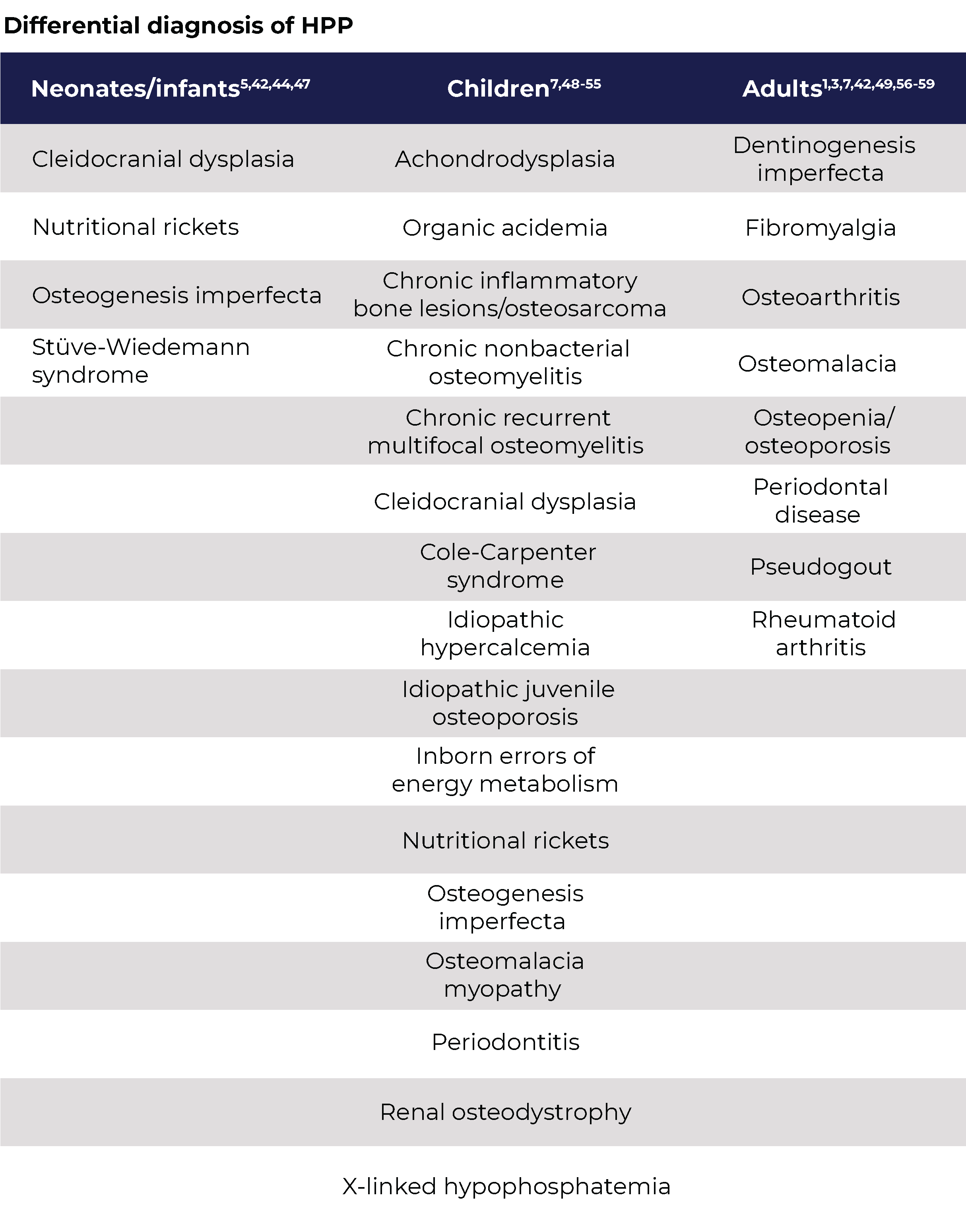
Differences in laboratory parameters are important when considering a differential diagnosis. Importantly, a low age- and sex-adjusted ALP activity level can assist in differentiating HPP from other skeletal-related disorders.14,27
Unlike patients with most forms of rickets or osteomalacia, patients with HPP have low ALP activity, not elevated ALP. In addition, patients with HPP do not have low serum calcium level and parathyroid hormone (PTH) levels are typically normal. However, some HPP patients may exhibit hypercalcemia with an accordingly low serum PTH level and low serum PTH levels may be evident when there is only hypercalciuria.22
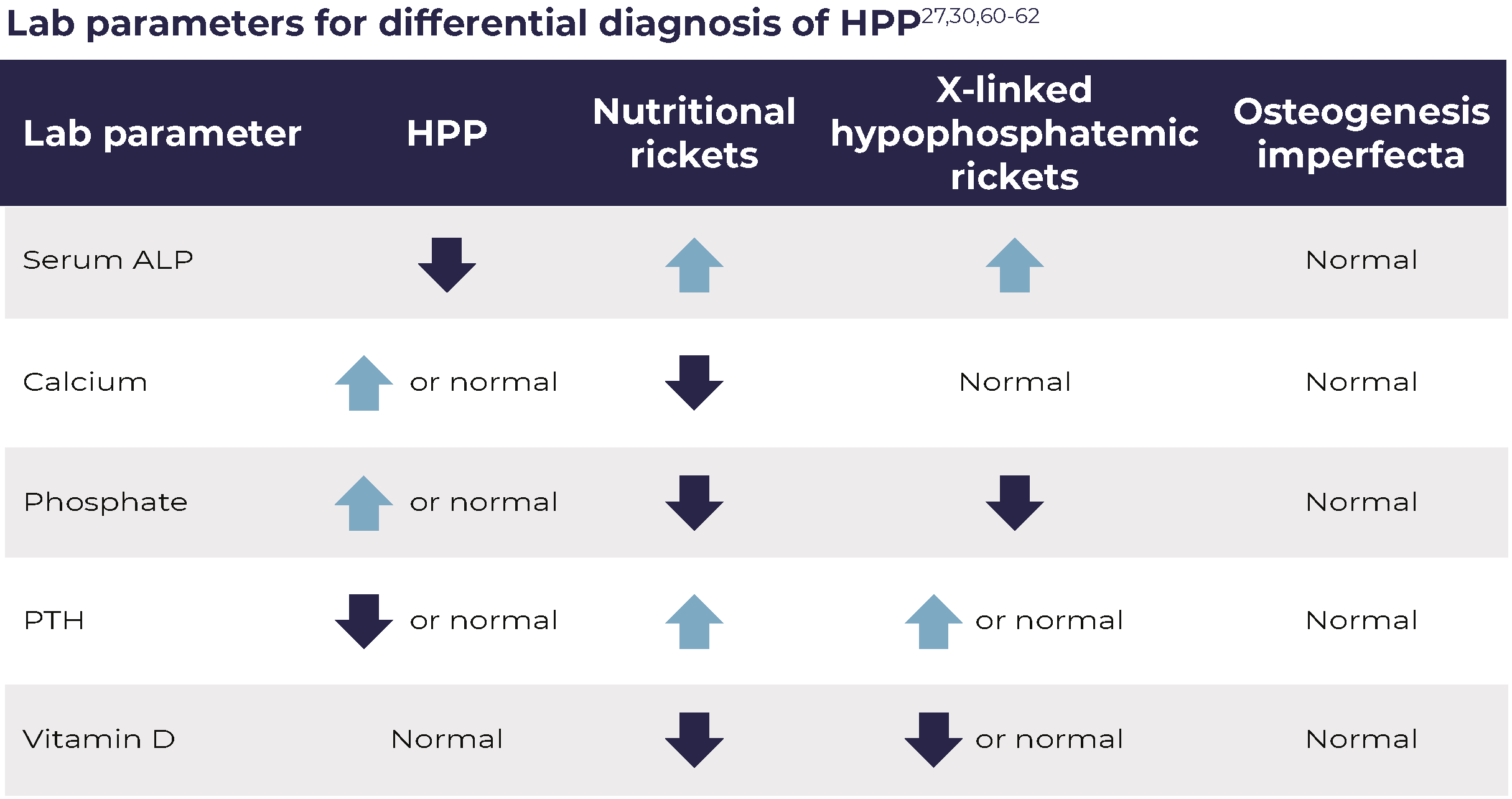
References
1. Whyte MP. Hypophosphatasia and the role of alkaline phosphatase in skeletal mineralization. Endocr Rev. 1994; 15: 439-461.
2. Whyte MP, Greenberg CR, Salman NJ et al. Enzyme-replacement therapy in life-threatening hypophosphatasia. N Engl J Med. 2012; 366: 904-913.
3. Rockman-Greenberg C. Hypophosphatasia. Pediatr Endocrinol Rev. 2013; 10 Suppl 2: 380-388.
4. Mornet E, Yvard A, Taillandier A et al. A molecular-based estimation of the prevalence of hypophosphatasia in the European population. Ann Hum Genet. 2011; 75: 439-445.
5. Whyte MP. Physiological role of alkaline phosphatase explored in hypophosphatasia. Ann NY Acad Sci. 2010; 1192: 190-200.
6. Fraser D. Hypophosphatasia. Am J Med. 1957; 22: 730-746.
7. Whyte MP. Hypophosphatasia. In: Thakker R, Whyte MP, Eisman J, Igarashi T, eds. Genetics of Bone Biology and Skeletal Disease. Elsevier Inc, 2013: 337-360.
8. Berkseth KE, Tebben PJ, Drake MT et al. Clinical spectrum of hypophosphatasia diagnosed in adults. Bone. 2013; 54: 21-27.
9. Riancho-Zarrabeitia L, García-Unzueta M, Tenorio JA et al. Clinical, biochemical and genetic spectrum of low alkaline phosphatase levels in adults. Eur J Intern Med. 2016; 29: 40-45.
10. Barvencik F, Beil FT, Gebauer M et al. Skeletal mineralization defects in adult hypophosphatasia - a clinical and histological analysis. Osteoporos Int. 2011; 22: 2667-2675.
11. Mornet E. The Tissue Nonspecific Alkaline Phosphatase Gene Mutations Database. Laboratoire SESEP. Available at: http://www.sesep.uvsq.fr/03_hypo_mutations.php.
12. ARUP Laboratories. Alkaline Phosphatase Isoenzymes, Serum or Plasma. Accessed September 27, 2023. https://ltd.aruplab.com/Tests/Pub/0021020.
13. Colantonio DA, Kyriakopoulou L, Chan MK et al. Closing the gaps in pediatric laboratory reference intervals: a CALIPER database of 40 biochemical markers in a healthy and multiethnic population of children. Clin Chem. 2012; 58: 854-868.
14. Bishop N, Munns CF, Ozono K. Transformative therapy in hypophosphatasia. Arch Dis Child. 2016; 101: 514-515.
15. Adeli K, Higgins V, Nieuwesteeg M et al. Biochemical marker reference values across pediatric, adult, and geriatric ages: establishment of robust pediatric and adult reference intervals on the basis of the Canadian Health Measures Survey. Clin Chem. 2015; 61: 1049-1062.
16. Schumann G, Klauke R, Canalias F et al. IFCC primary reference procedures for the measurement of catalytic activity concentrations of enzymes at 37 °C. Part 9: reference procedure for the measurement of catalytic concentration of alkaline phosphatase. International Federation of Clinical Chemistry and Laboratory Medicine (IFCC) Scientific Division, Committee on Reference Systems of Enzymes (C-RSE). Clin Chem Lab Med. 2011; 49: 1439-1446.
17. Quest Diagnostics. Alkaline phosphatase. Accessed September 27, 2023. https://testdirectory.questdiagnostics.com/test/test-detail/234/alkaline-phosphatase?cc=MASTER.
18. Labcorp. Alkaline phosphatase. Accessed September 27, 2023. https://www.labcorp.com/tests/001107/alkaline-phosphatase.
19. Mornet E, Nunes M. Hypophosphatasia. In: Pagon R, Adam M, Ardinger H, et al, eds. GeneReviews®. Seattle (WA): University of Washington, 2011.
20. Mori M, DeArmey SL, Weber TJ et al. Case series: Odontohypophosphatasia or missed diagnosis of childhood/adult-onset hypophosphatasia? - Call for a long-term follow-up of premature loss of primary teeth. Bone Rep. 2016; 5: 228-232.
21. Högler W, Langman C, Gomes da Silva H et al. Diagnostic delay is common among patients with hypophosphatasia: initial findings from a longitudinal, prospective, global registry. BMC Musculoskelet Disord. 2019; 20: 80.
22. Whyte MP. Hypophosphatasia. In: Glorieux F, Pettifor J, Juppner H, eds. Pediatric Bone. Elsevier, 2012: 771-794.
23. Whyte MP. Hypophosphatasia: nature's window on alkaline phosphatase function in humans. In: Bilezikian JP, Raisz LG, Martin TJ, eds. Principles of Bone Biology. San Diego, CA: Elsevier, 2008: 1573-1598.
24. Leung EC, Mhanni AA, Reed M et al. Outcome of perinatal hypophosphatasia in manitoba mennonites: a retrospective cohort analysis. JIMD Rep. 2013; 11: 73-78.
25. Whyte MP, Rockman-Greenberg C, Ozono K et al. J Clin Endocrinol Metab. 2016; 101: 334-342.
26. Whyte MP, Murphy WA, Fallon MD. Adult hypophosphatasia with chondrocalcinosis and arthropathy. Variable penetrance of hypophosphatasemia in a large Oklahoma kindred. Am J Med. 1982; 72: 631-641.
27. Mohn A, De Leonibus C, de Giorgis T et al. Hypophosphatasia in a child with widened anterior fontanelle: lessons learned from late diagnosis and incorrect treatment. Acta Paediatr. 2011; 100: e43-e46.
28. Mornet E. Hypophosphatasia. Orphanet J Rare Dis. 2007; 2: 40.
29. Whyte MP, Leung E, Wilcox WR et al. Natural history of perinatal and infantile hypophosphatasia: a retrospective study. J Pediatr. 2019; 209: 116-124.e114.
30. Bloch-Zupan A. Hypophosphatasia: diagnosis and clinical signs - a dental surgeon perspective. Int J Paediatr Dent. 2016; 26: 426-438.
31. Surtees R, Mills P, Clayton P. Inborn errors affecting vitamin B6 metabolism. Future Neurol. 2006; 1: 615-620.
32. Balasubramaniam S, Bowling F, Carpenter K et al. Perinatal hypophosphatasia presenting as neonatal epileptic encephalopathy with abnormal neurotransmitter metabolism secondary to reduced co-factor pyridoxal-5'-phosphate availability. J Inherit Metab Dis. 2010; 33 Suppl 3: S25-S33.
33. Collmann H, Mornet E, Gattenlöhner S et al. Neurosurgical aspects of childhood hypophosphatasia. Childs Nerv Syst. 2009; 25: 217-223.
34. Linglart A, Biosse-Duplan M. Hypophosphatasia. Curr Osteoporos Rep. 2016; 14: 95-105.
35. Belachew D, Kazmerski T, Libman I et al. Infantile hypophosphatasia secondary to a novel compound heterozygous mutation presenting with pyridoxine-responsive seizures. JIMD Rep. 2013; 11: 17-24.
36. Buchet R, Millán JL, Magne D. Multisystemic functions of alkaline phosphatases. Methods Mol Biol. 2013; 1053: 27-51.
37. Genest F, Seefried L. Subtrochanteric and diaphyseal femoral fractures in hypophosphatasia-not atypical at all. Osteoporos Int. 2018; 29: 1815-1825.
38. Coe JD, Murphy WA, Whyte MP. Management of femoral fractures and pseudofractures in adult hypophosphatasia. J Bone Joint Surg Am. 1986; 68: 981-990.
39. Bloch-Zupan A, Alembik Y, Doray B et al. Oro-dental features in hypophosphatasia: a valuable phenotype for disease diagnosis and evaluation of future treatment outcomes. Bull Group Int Rech Sci Stomatol Odontol. 2012; 51: e13.
40. Eade AW, Swannell AJ, Williamson N. Pyrophosphate arthropathy in hypophosphatasia. Ann Rheum Dis. 1981; 40: 164-170.
41. Colazo JM, Hu JR, Dahir KM et al. Neurological symptoms in Hypophosphatasia. Osteoporos Int. 2019; 30: 469-480.
42. Mornet E, Nunes ME. Gene Reviews®: Hypophosphatasia. Available at: http://www.ncbi.nlm.nih.gov/books/NBK1150/.
43. Sutton RAL, Mumm S, Coburn SP et al. "Atypical femoral fractures" during bisphosphonate exposure in adult hypophosphatasia. J Bone Miner Res. 2012; 27: 987-994.
44. Whyte MP. Atypical femoral fractures, bisphosphonates, and adult hypophosphatasia. J Bone Miner Res. 2009; 24: 1132-1134.
45. McKiernan FE, Berg RL, Fuehrer J. Clinical and radiographic findings in adults with persistent hypophosphatasemia. J Bone Miner Res. 2014; 29: 1651-1660.
46. Taillandier A, Domingues C, De Cazanove C et al. Molecular diagnosis of hypophosphatasia and differential diagnosis by targeted Next Generation Sequencing. Mol Genet Metab. 2015; 116: 215-220.
47. Di Rocco F, Rothenbuhler A, Cormier Daire V et al. Craniosynostosis and metabolic bone disorder. A review. Neurochirurgie. 2019; 65: 258-263.
48. Silva I, Castelao W, Mateus M et al. Childhood hypophosphatasia with myopathy: clinical report with recent update. Acta Reumatol Port. 2012; 37: 92-96.
49. Mornet E, Beck C, Bloch-Zupan A et al. Clinical utility gene card for: hypophosphatasia. Eur J Hum Genet. 2011; 19.
50. Watanabe H, Umeda M, Seki T et al. Clinical and laboratory studies of severe periodontal disease in an adolescent associated with hypophosphatasia. A case report. J Periodontol. 1993; 64: 174-180.
51. Girschick HJ, Mornet E, Beer M et al. Chronic multifocal non-bacterial osteomyelitis in hypophosphatasia mimicking malignancy. BMC Pediatr. 2007; 7: 3.
52. Nikkel SM. Skeletal dysplasias: what every bone health clinician needs to know. Curr Osteoporos Rep. 2017; 15: 419-424.
53. Stokes VJ, Nielsen MF, Hannan FM et al. Hypercalcemic disorders in children. J Bone Miner Res. 2017; 32: 2157-2170.
54. Whyte MP, Wenkert D, McAlister WH et al. Chronic recurrent multifocal osteomyelitis mimicked in childhood hypophosphatasia. J Bone Miner Res. 2009; 24: 1493-1505.
55. Rush ET. Childhood hypophosphatasia: to treat or not to treat. Orphanet J Rare Dis. 2018; 13: 116.
56. Braunstein NA. Multiple fractures, pain, and severe disability in a patient with adult-onset hypophosphatasia. Bone Rep. 2016; 4: 1-4.
57. O'Duffy JD. Hypophosphatasia associated with calcium pyrophosphate dihydrate deposits in cartilage. Report of a case. Arthritis Rheum. 1970; 13: 381-388.
58. Martins L, de Almeida AB, Dos Santos EJL et al. A novel combination of biallelic ALPL mutations associated with adult hypophosphatasia: a phenotype-genotype association and computational analysis study. Bone. 2019; 125: 128-139.
59. Rauch F, Bardai G, Rockman-Greenberg C. ALPL mutations in adults with rheumatologic disorders and low serum alkaline phosphatase activity. J Bone Miner Metab. 2019; 37: 893-899.
60. Roth KS, Chan JCM, Rosenbloom a et al. Hypophosphatemic Rickets. Available at: https://emedicine.medscape.com/article/922305-overview.
61. Santos F, Fuente R, Mejia N et al. Hypophosphatemia and growth. Pediatr Nephrol. 2013; 28: 595-603.
62. Baroncelli GI, Toschi B, Bertelloni S. Hypophosphatemic rickets. Curr Opin Endocrinol Diabetes Obes. 2012; 19: 460-467.
The information on this page is intended as educational information for healthcare professionals. It does not replace a healthcare professional’s judgement or clinical diagnosis.
